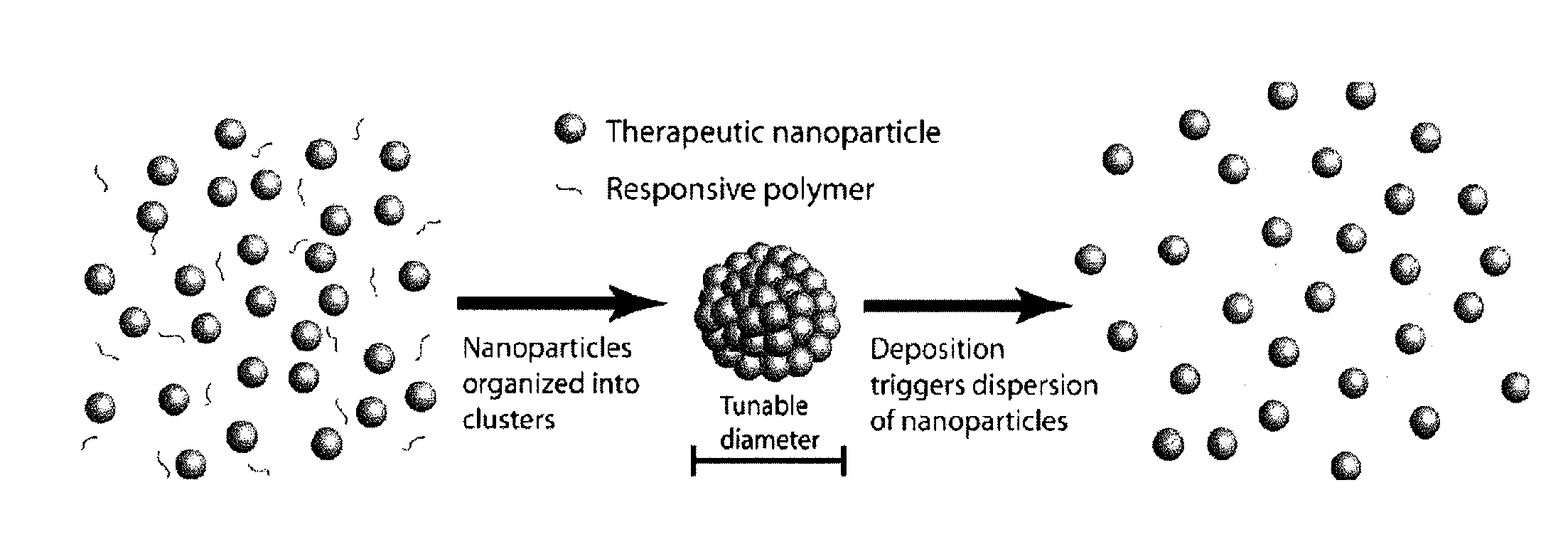Nanoclusters for delivery of therapeutics
a nano-particle and nano-particle technology, applied in the field of nano-particle delivery vehicles, can solve the problems of inability to control the size of microparticles, inability to access the cellular target, and inability to achieve the effect of improving the performance of the second active ingredien
- Summary
- Abstract
- Description
- Claims
- Application Information
AI Technical Summary
Benefits of technology
Problems solved by technology
Method used
Image
Examples
example 1
Nano-Clusters with Responsive Dispersion
[0104] Nano-Cluster Formation: Nano-clusters of the present invention can be prepared by the following procedure: Two syringe pumps (Harvard Apparatus 4400 and Isco) are connected to the inner and outer ports of a coaxial nozzle to pass a colloidal suspension of nano-particles (see above formulation) in aqueous solution and 1-octanol (Fisher Scientific) as droplet carrying liquid, respectively. The two immiscible liquids are injected at appropriate flows to produce monodisperse aqueous droplets, which contain the colloidal suspension of nano-particles, in the octanol phase. The nano-clusters are formed after water in the droplets dissolves into 1-octanol resulting in packing of the nano-particles into a spherical structure (FIG. 4). Nano-clusters are then washed with ethanol to remove residual 1-octanol and can be freeze dried for analysis. Similar results were achieved by simply adding the nano-particle suspension to the octanol phase and st...
example 2
Self-Assembled Nano-clusters
[0107] Nano-Particle Formation: PLGA nanoparticles were prepared by a modified emulsion / solvent extraction method using different polyelectrolyte coating materials to control surface charge (Table 1). Polyvinylamine (PV Am) was used as a cationic coating material and was synthesized in house (see Experimental). Polyethylene-alt-maleic acid (PEMA) was synthesized by hydrolysis of the anhydride from of this polymer as adapted from methods reported previously. The resulting polyelectrolyte-coated PLGA nanoparticles possessed excellent uniformity and high surface charge (Table 1). Each nano-particle formulation was analyzed for size and zeta potential using dynamic light scattering and conductivity measurements (Brookhaven ZetaPALS), respectively, in the appropriate media (water or organic). Studies confirmed the maintenance of particle surface charge upon lyophilization and after more than one week of incubation at 37° C., pH 7.4 (data not shown). PVAm-coat...
example 3
Preparation of Nifedipine and Loratadine Nanoparticles
[0111] The following includes examples of preparing various non-limiting nifedipine and loratadine nanoparticles.
[0112] 1020 nm Nifredipine nanoparticle—Nifedipine (50 mg) was dissolved in 3 ml of methylene chloride. Dumped nifedipine solution into 0.125% Cetyltrimethylammonium bromide (CTAB) solution (30 mL) and sonicated for 60 s. The particle suspension was placed into a hood for two hours to evaporate the methylene chloride. The resulting nanoparticle had a particle size of 1020 nm and a polydispersity of 0.24.
[0113] 660 nm Nifedipine nanoparticle—Nifedipine (50 mg) was dissolved in 3 ml of methylene chloride. Dumped nifedipine solution into 0.5% CTAB solution (30 mL) and sonicated for 60 s. The particle suspension was placed into a hood for two hours to evaporate the methylene chloride. The resulting nanoparticle had a particle size of 660 nm and a polydispersity of 0.17.
[0114] 480 nm Nifedipine nanoparticle—Nifedipine (...
PUM
| Property | Measurement | Unit |
|---|---|---|
| size | aaaaa | aaaaa |
| size | aaaaa | aaaaa |
| size | aaaaa | aaaaa |
Abstract
Description
Claims
Application Information
 Login to View More
Login to View More - R&D
- Intellectual Property
- Life Sciences
- Materials
- Tech Scout
- Unparalleled Data Quality
- Higher Quality Content
- 60% Fewer Hallucinations
Browse by: Latest US Patents, China's latest patents, Technical Efficacy Thesaurus, Application Domain, Technology Topic, Popular Technical Reports.
© 2025 PatSnap. All rights reserved.Legal|Privacy policy|Modern Slavery Act Transparency Statement|Sitemap|About US| Contact US: help@patsnap.com



